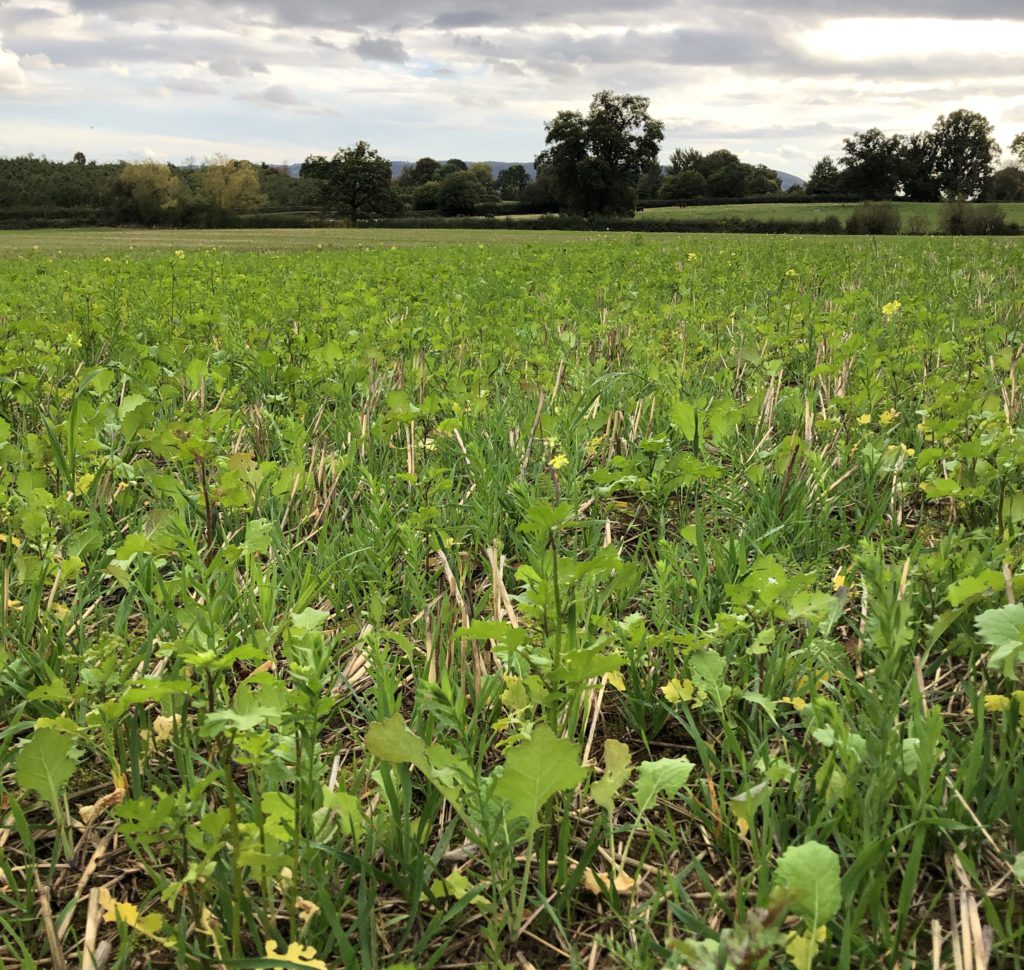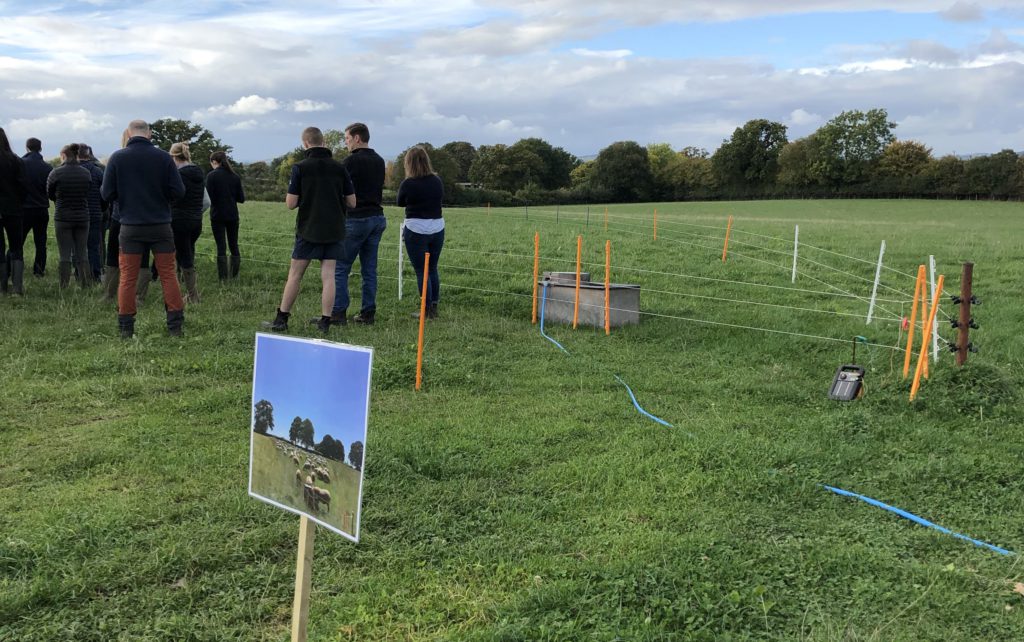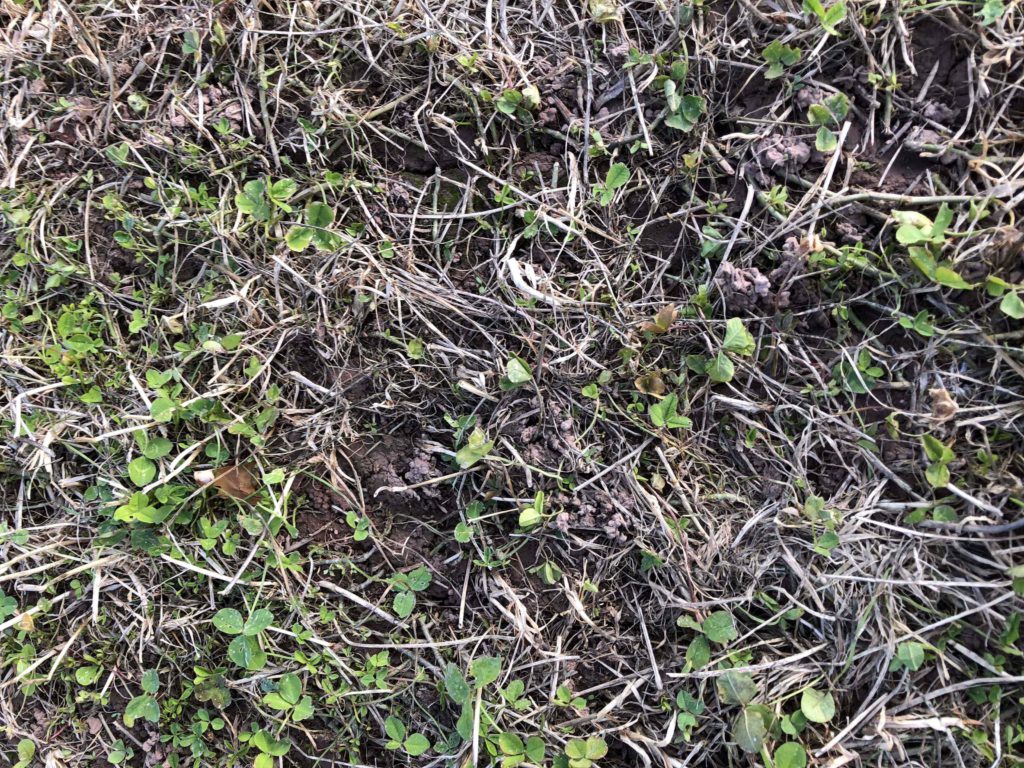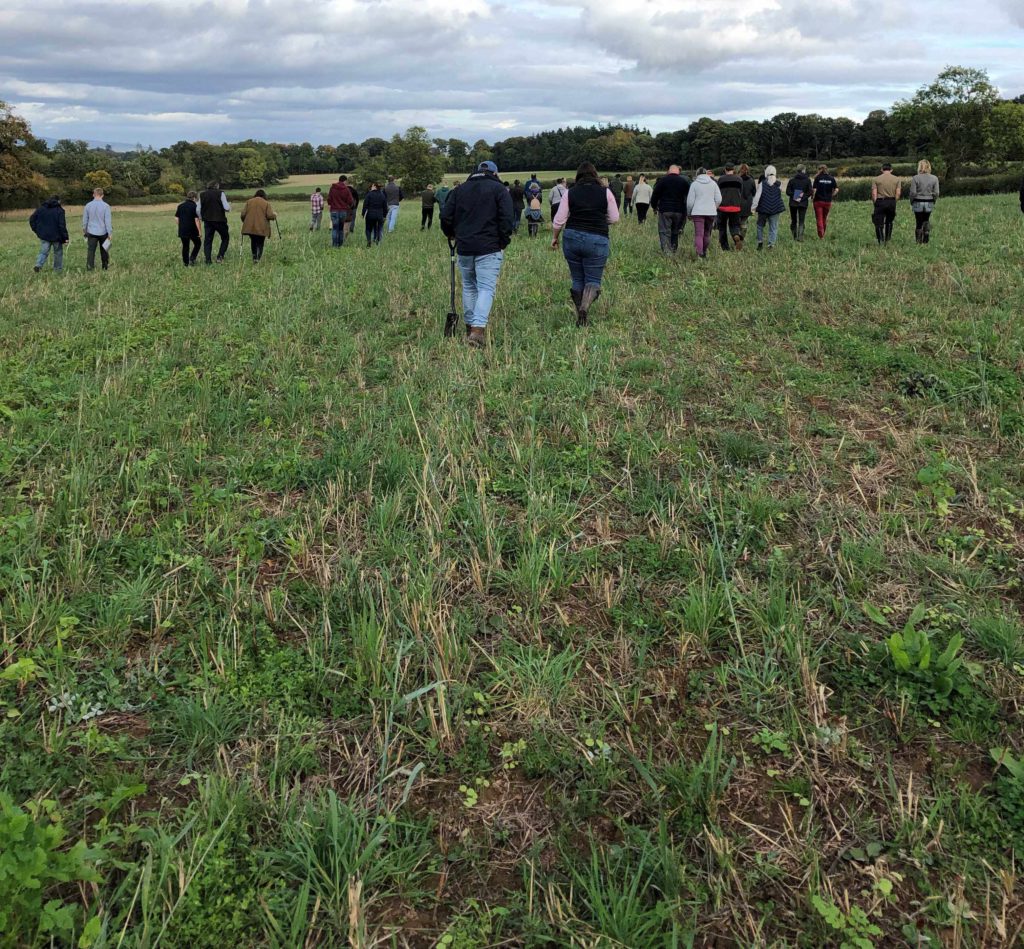
Our 2022 Mixed Soil Farmer of the Year, Billy Lewis, is based at Boycefield Farm in Herefordshire on a 350 acre beef and sheep farm. The farm soils are medium loamy with areas of heavy clay. Billy’s business includes around 100 head of pedigree Hereford cattle, a flock of 300 ewes and an additional arable enterprise. In October 2022 over 100 farmers, advisors and industry personnel met at Boycefield to learn more about the system that led Billy to win the competition.
Approach
Billy’s approach was historically sympathetic and typical of many mixed farms, with grassland alongside an arable area used to produce crops and fodder to raise livestock. However previous management on the arable land has seen some degradation through root crops in the rotation, in particular lifting potatoes in the wet harvest of 2008 and grass yields were stagnant. Over the past 5 years the farm has seen some radical changes with regards to soil management and, consequently, this has improved profitability in both the arable and grassland systems with reduced requirement for artificial inputs. Billy has transitioned away from renting land for potatoes and a predominantly high-input, plough based-system on the arable side, and an overall reliance on bagged nitrogen across the whole farm.
Now management is focused on a direct drilling regime, living mulches, catch and cover cropping alongside integrating livestock into the arable system to maintain diversity throughout the farm. Furthermore, the grazing platform has developed from a field-by-field rotational grazing system over the past 3 years to that of a high-impact, long recovery mob grazing approach; transitioning from monoculture grass leys into diverse herbal and legume leys with added natural regeneration of plants within the historic seedbank, resulting in a near total removal of artificial nitrogen requirement.

Speaking to the group, Billy described his process in altering the management undertaken at the farm,
“The first year we started putting up a few electric fences over a small area to try rotational grazing. Alongside this we tried around 5 acres of direct drilling. As these two approaches worked quite well the year after we increased the area and so on and so forth.”
The focus at Boycefield is upon building soil health and quality to increase the resilience of the system (either grassland or arable) alongside a capacity to utilise the nutrients already available below the ground,
“Our approach on the farm is to use what we have on the farm – sun, rain and the soil – if we get the soil right then in theory everything should fall into line.”
To aid this Billy has an integrated system whereby all of the farm with the exception of the permanent pasture will rotate between arable and forage cropping, with livestock featured throughout regardless of what is planted,
“We tend to have three years of cereals with grazable cover or catch crops followed by three years in grass or herbal leys to build the fertility – this is either silaged or grazed depending on what is required for the year”.

Much of the permanent pasture is zero input, without cultivation or additional manures outside of what is deposited during grazing from animal impact, Billy explains,
“Since beginning our rotational grazing system we no longer apply fertiliser to our permanent pasture. You will grow ten times more grass with an electric fence than you will with a bag of fertiliser”.
Across Boycefield farm fertiliser use has been reduced by more than 50% over the last three years,
“The ultimate aim is to no longer use pesticides or artificial fertilisers.”
Conversion to mob grazing
Historically fields were set stocked, Billy believed that this was a main blocker on the potential biodiversity of the farm. A mob grazing system with long rest periods allows the natural seedbank within the soil to regenerate. The cattle are on a 48 hour system, whereby they are moved into a new paddock every two days with each paddock being grazed around 5 times throughout the summer season.
Billy demonstrates his grazing system, utilising the approach of graze a third, leave a third and trample a third,
“The livestock are kept happy with the grass available, whilst the plants left have leaf area to continue photosynthesising and the remaining third which is trampled in is boosting the below-ground biology.”
The farm utilises a leader-follower system, where the sheep graze in-front with the cattle following behind; this allows the sheep to take the majority of the lush and tall grass which is less suitable for the Hereford cattle, which perform better on the permanent or older grass pastures. On a particularly tricky year with the drought Billy discussed how this system had fared,
“It has become apparent that this is the method we should be using to grow grass, fields we went into with high covers recovered faster with ground moisture being maintained alongside that remaining leaf area.”
Although the system is based on 48 hour moves between paddocks, Billy keeps this flexible – altering the area available in cases such as holidays or in the extreme heat to allow for better shading,
“The grazing system is a balancing act between your own life and the farm life – I don’t get too hung up on moving animals or having a set plan so we can adapt to the season, the demands of the animals and the ground”.
In regards to the performance of the livestock, Billy shares,
“The stock know that every 2 to 3 days they will be moved to fresh grass – they are calm, happy and well. The cattle have a lovely shine to their coats and lambs are performing really well on a purely forage based diet.”

Cattle are wormed a week prior to turn-out when in the shed but treatment is not repeated – Billy relies on regular movement and an increased sward height to reduce the parasitic worm burden and likewise increase the dung beetle population through minimising anthelmintics onto the pasture. Billy mentions that a group of lambs made it to market this year without a single worming treatment, he explains,
“We would never not treat an animal if we thought the need was there, however, with our system worming is no longer a high priority – the animals tend to stay ahead of them and therefore have much lower contact.”

Compost
Cattle are housed over winter and all of the resulting farmyard manure is composted and then used on the arable fields, either into a standing crop in the spring or prior to drilling in the autumn. Billy describes,
“With compost it is a case of little and often.”
Adapting the compost to field requirement, Billy has previously added solid digestate fibre to his compost mix to increase the nutrient content available. All of the straw from the arable system is baled to use in the livestock, however it is then returned via the compost which Billy sees as far more beneficial to the soil and crop being grown. The compost is produced through windrowing the muck and using a compost turner to mix, around about 4 to 5 times before the finished product is realised – being much more in texture to that of the soil, being capable of spreading around 24m at a rate of 6-10 tonnes per hectare.

Diversity and reducing inputs
The group looked at an arable field that was just coming out of the three year fertility break – consequently the field has been planted with a three-way blend of wheat (Extase, Costello and Graham) using a direct drill. The seed used is currently dressed, however in the coming years Billy looks to minimise this,
“We are aiming to have half of the wheat undressed next year, we have wireworm within the soils but are yet to see worrying levels of damage – there is so much variety in the soils and also in what we are growing above ground, they don’t seem to bother with the crop”.
Billy uses contractors for some of the cultivation and spraying work, so minimising the number of passes required equally reduces the overall spend requirement for the crop. The field was sprayed off with glyphosate at 2.5 l/ha with 0.5 l/ha of fulvic acid and 80g of citric acid, which left a clover understorey to act as a living mulch for the combinable crops. Billy explains,
“Traditionally I wouldn’t go out of my way to establish clover in an arable crop, but as it is already here and very well established I will capitalise on it. We have done it the last three years and seen some good successes.”
He continues,
“As much diversity you can get in a system the better, in what is usually a monoculture crop of wheat we now have clover roots and three different varieties”.

When looking at a field which has had a clover understorey for the past two seasons Billy explains his method,
“Originally this was wheat direct drilled into a herbal ley and the clover persisted, after harvest we then direct drilled some more mustard and phacelia in to provide some different rooting architecture and sheep grazing. We grazed around 70 sheep for 10 days on the field which could take back the green cover before we have now planted our second wheat.”
Billy uses Humber Palmers fertiliser in a three way split, of roughly 10kg in March and then a following 20kg later in the season before the final dose which is applied as a foliar with humates. The fertiliser program going forward is much reduced to the traditional application rate, Billy explains,
“We are budgeting 50 kg of nitrogen per hectare for this wheat crop, last year the wheat with a living mulch had 60 kg of nitrogen per hectare and one fungicide at T2 and yielded over 10 t/ha, making it likely the most profitable crop of wheat we’ve ever grown on the farm. Therefore it would be nice to go zero fungicide this year and reduce the fertiliser rate further, however if the crop is looking stressed or like it needs more we would always consider increasing the inputs.”
Having livestock available to the arable system keeps management flexible, with Billy having the capacity to graze particularly forward crops to reduce the requirement for fungicides later in the season.
Restoring soil health with cover cropping
The walk visited one of the poorest fields on the farm, which is currently undergoing a process to restore soil quality, health and fertility. Billy explained to the group,
“We started in here with a winter cover crop which was grazed off by lambs intended to go into spring barley. However the field was still very poor and with the current fertiliser prices we didn’t feel like we would get anything other than a marginal crop – so instead we planted a summer cover crop (buckwheat, phacelia, mustard, chicory, oats, crimson clover, rye, vetch) and focussed on restoring the soil to a position where the field could function in our low-input system.”
The field has now been direct drilled with a GS4 herbal ley as part of the farm’s stewardship scheme, with a planned winter grazing to remove any remaining plants from the summer cover crop – anything that is left within the herbal ley will be seen as a bonus to the overall diversity.


Further explaining the cover cropping system, Billy showed the group a previous oat stubble with freshly drilled winter wheat,
“This field had compost in the spring for the oat crop, straight after combining we establish a catch crop (mustard, buckwheat and phacelia) with a disc drill to create a little tilth and allow any weeds to chit. This catch crop will be in the ground for 6-7 weeks to capture the sunlight and keep the soil life ticking over and cycling nutrients before we desiccate it and drill the following crop.”
Upon digging a hole, Billy mentions,
“When we have been out digging we have noticed some phenomenal plant Rhizosheaths, most noticeably in our cover crops where the plant roots are absolutely laden in soil. This is a great sign, it shows us that our soil biology is functioning and forming great symbiotic relationships with the crop.”
He continues,
“When we dig up any legume species, be it in a herbal ley, cover crop or in the clover living mulch, we’re seeing plenty of nodules forming and more importantly we are noticing that they are active due to the dark purple colour when they are sliced open.”
Moving forward
The next steps at Boycefield are to reduce input usage further, focusing on utilising what is available on the farm. Billy has now taken on additional local arable land after demonstrating the benefits of a more regenerative, resilient system. Boycefield has started running a number of farm walks throughout the year to show other visitors what they are up to.
Follow Billy
Equally, Billy shares the daily goings on for the farm on twitter (@BoycefieldFarm) and on the Boycefield Farm website – a great platform to see all of the wonderful photos of the farm throughout the year.

